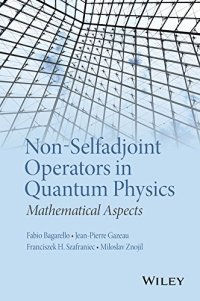
Ebook: Non-Selfadjoint Operators in Quantum Physics: Mathematical Aspects
- Tags: Nonselfadjoint operators, Spectral theory (Mathematics), Quantum theory -- Mathematics, Hilbert space, SCIENCE / Energy, SCIENCE / Mechanics / General, SCIENCE / Physics / General
- Year: 2015
- Publisher: John Wiley & Sons
- Edition: 1
- Language: English
- pdf
A unique discussion of mathematical methods with applications to quantum mechanics
Non-Selfadjoint Operators in Quantum Physics: Mathematical Aspects presents various mathematical constructions influenced by quantum mechanics and emphasizes the spectral theory of non-adjoint operators. Featuring coverage of functional analysis and algebraic methods in contemporary quantum physics, the book discusses the recent emergence of unboundedness of metric operators, which is a serious issue in the study of parity-time-symmetric quantum mechanics. The book also answers mathematical questions that are currently the subject of rigorous analysis with potentially significant physical consequences. In addition to prompting a discussion on the role of mathematical methods in the contemporary development of quantum physics, the book features:
- Chapter contributions written by well-known mathematical physicists who clarify numerous misunderstandings and misnomers while shedding light on new approaches in this growing area
- An overview of recent inventions and advances in understanding functional analytic and algebraic methods for non-selfadjoint operators as well as the use of Krein space theory and perturbation theory
- Rigorous support of the progress in theoretical physics of non-Hermitian systems in addition to mathematically justified applications in various domains of physics such as nuclear and particle physics and condensed matter physics
An ideal reference, Non-Selfadjoint Operators in Quantum Physics: Mathematical Aspects is useful for researchers, professionals, and academics in applied mathematics and theoretical and/or applied physics who would like to expand their knowledge of classical applications of quantum tools to address problems in their research. Also a useful resource for recent and related trends, the book is appropriate as a graduate-level and/or PhD-level text for courses on quantum mechanics and mathematical models in physics.